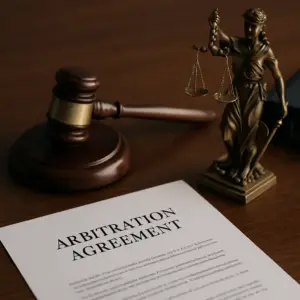How Construction Delays Lead to Legal Battles (and How to Avoid Them)
September 11, 2025
Share Article:
Settling disputes with our online arbitration services is easy, fast, and affordable.
We look forward to answering your questions and helping you to reach conflict resolution with our online arbitration service.

Handling Non-Compete Violations Without Going to Court
A non-compete agreement is a type of restrictive covenant commonly found in an employment contract. Employers often require employees to sign these contracts to prevent job hopping, safeguard trade secrets, and protect client relationships. At their core,

Arbitration vs. Litigation in Texas: A Cost Comparison
For Texas businesses facing legal disputes, selecting the right dispute resolution mechanism is a critical decision. Two common options are arbitration and litigation, each with distinct advantages, challenges, and cost implications.

How Freelancers Can Use Arbitration to Settle Payment Disputes
Freelancing offers freedom, flexibility, and the opportunity to shape your own career—but it also comes with risks. Chief among them? Clients who don’t pay. Whether you’re a graphic designer waiting on a final invoice or a developer facing payment disputes over

Commercial Arbitration Services in Los Angeles: What Businesses Need to Know
Los Angeles is home to one of the most sophisticated and dynamic business communities in the country. From startup founders to private equity funds and insurance companies, businesses in this region increasingly rely on alternative dispute

Is Arbitration Legally Binding? Understanding the Fine Print
If you’ve ever signed a contract for a job, a credit card, or even a cell phone plan, chances are you’ve agreed to arbitration—maybe without even realizing it. But is arbitration legally binding? And what does that actually mean for you as a consumer? Understanding
Understanding Construction Delays
Construction projects succeed or fail on the strength of the contract, the project schedule, and disciplined project management. When construction delays stack up, costs rise, completion timelines slip, and relationships between property owners, contractors, and subcontractors strain. If the delay becomes a breach of contract or triggers liquidated damages, the result is often a legal claim that escalates into formal dispute resolution. Delays can be caused by site conditions, regulatory approvals, design and approval delays, labor shortages, material shortages, supply chain disruptions, or owner-caused changes. Clear contract clauses, accurate documentation, and practical risk management strategies can keep a project on track and keep legal issues out of court.
Types of Delays You Must Identify Early
Not all project delays are treated the same under construction law or in construction contracts. Understanding what type you are facing informs the right remedy.
- Excusable vs. Non-Excusable: Excusable delays are outside a party’s control, such as severe weather or local permitting backlogs. Non-excusable delays often stem from poor project management or late mobilization.
- Compensable vs. Non-Compensable: Compensable delays may entitle the impacted party to time extensions and delay damages. Non-compensable delays typically allow time extensions only.
- Concurrent Delays: When multiple causes overlap, delay assessments require careful schedule analysis to determine responsibility and exposure to penalty clauses.
The Society of Construction Law’s Delay and Disruption Protocol is a helpful reference for delay analysis protocols and notice and documentation expectations; it is widely cited by experts and tribunals in construction disputes.
Common Causes Behind Project Schedule Slippage
Construction delays often trace back to predictable patterns that strong contract administration can manage.
- Weather Conditions: Abnormal weather can be an excusable delay if the contract defines thresholds and requires timely notice. Historical and actual weather reports help validate claims.
- Labor Shortages and Labor Disputes: Workforce gaps, safety stand-downs, or workers’ compensation incidents affect productivity and may trigger time extensions if properly documented.
- Supply Chain Issues and Material Shortages: Long lead items, source materials with limited vendors, and international shipping constraints can disrupt the critical path.
- Permitting Process and Regulatory Approvals: Local zoning approvals, building codes, fire marshal sign-offs, and environmental reviews vary by jurisdiction. New York City, Long Island, and coastal South Carolina often see seasonal backlogs and hurricane-related volume spikes.
- Owner-Caused Delays and Scope of Work Creep: Late decisions, extensive design revisions, and payment disputes can interrupt sequential trades.
- Site Conditions: Differing site conditions and concealed utilities call for rapid notice and change order workflows.
The Contract Is Your Roadmap: Clauses That Decide Outcomes
Well drafted construction contracts set expectations for schedule delay, time extensions, and dispute resolution mechanisms. Look closely at:
- Force Majeure: Defines uncontrollable events that excuse performance and may allow time extensions. Precise language is critical.
- Liquidated Damages and Per Diem Monetary Amounts: Pre-agreed delay damages tied to missed milestones or contract deadlines.
- Notice and Documentation Requirements: Strict timing for delay claims, with requirements for weather reports, manpower logs, delivery receipts, and daily reports.
- Milestone-Based Payments and Payment Schedules: Payment releases tied to completion percentages reduce payment disputes.
- Performance Bonds and Insurance: Safeguards that address contractor default, delay damages, or an insurance claim after catastrophic events.
- Dispute Resolution Mechanisms: Negotiation, mediation, arbitration, or litigation, often in that order.
Helpful neutral references include the AIA’s standard contract framework and case law overviews on force majeure. - AIA Contract Documents overview
When Delays Become Legal Issues
Delays move from project management problems to legal matters when contractual provisions are triggered. Examples include missed substantial completion dates that activate liquidated damages, failure to meet notice and documentation deadlines, or persistent owner-caused interference that justifies a construction delay claim. Disagreements over entitlement, quantum, and concurrency can escalate fast. At that point, dispute resolution is guided by the agreement’s clause order. Many contracts require negotiation and mediation before arbitration or legal action. If the contract is silent, local rules and real estate development norms fill the gap.
How Arbitrators and Courts Evaluate Delay Claims
Decision makers look for factual matters proven with contemporaneous records and a clear critical path narrative. Strong submissions typically include:
- Baseline and Updated Schedules: Primavera or equivalent outputs that show slippage on the critical path and float erosion.
- Delay Analysis Protocols: Windows, time-impact analysis, or as-planned versus as-built methods that attribute delay to specific causes.
- Corroboration: Daily reports, RFIs, meeting minutes, submittal logs, change orders, and photos or drone progress captures.
- Objective Evidence: NOAA weather data, delivery receipts, certified payrolls, and inspection sign-offs.
For authoritative weather data, see the National Weather Service and NOAA resources, which are frequently used to substantiate excusable weather delays. - NOAA Climate Data: NOAA
Practical Strategies to Prevent Delays and Disputes
Prevention is far less expensive than litigation. The following strategies reduce schedule risk and improve contractual certainty:
- Front-Load Planning: Confirm long-lead source materials, prequalify subs, and finalize shop drawings before critical mobilization.
- Contract Negotiation with Clarity: Align on Scope of Work, submittal durations, inspection sequences, regulatory approvals, and what qualifies for time extensions.
- Contingency Time and Float Management: Build in contingency time for jurisdictions with known local permitting backlogs or seasonal weather risks.
- Quality Control Measures and Regular Inspections: Early detection prevents rework and protects the critical path. OSHA’s construction safety standards also reduce stop-work events.
- Risk Registers and Escalation Triggers: Agree on thresholds that escalate issues to senior stakeholders before delays become disputes.
Helpful references: - OSHA Construction Standards: OSHA
Documentation Playbook: Build the Record as You Build the Project
Thorough, organized documentation wins delay claims and helps settle disputes early. Establish information repositories and consistent communication channels from day one. Capture:
- Notice Letters: Timely, contract-compliant notice and documentation for every potential schedule impact.
- Daily Reports and Time Stamps: Labor counts, equipment on site, weather observations, and material deliveries.
- RFI and Submittal Logs: Track design clarifications and approval cycle times to support time extensions.
- Change Orders and Pricing Back-Up: Tie every change to the schedule and cost.
- Inspection and Test Records: Closeout is faster when test data, punch lists, and final inspection reports are complete and signed.
Consistent formats across teams reduce disputes about factual matters and create a clear picture for any mediator, arbitrator, or judge.
GEO Considerations That Change the Risk Profile
Construction law is applied within local building codes, zoning laws, and permitting processes. Geography drives delay risk and dispute resolution strategy.
- Northeast and Mid-Atlantic: Winter weather, union labor calendars, and dense urban inspection regimens in places like New York City can slow approvals.
- Coastal Carolinas and the Gulf: Storm seasons increase force majeure exposure and can cause supply chain disruptions. Pre-storm material staging and emergency response plans reduce schedule delay after landfall.
- Western States: Wildfire smoke interruptions, water restrictions, and seismic codes affect sequencing and inspection pacing.
Align delay analysis with the location’s unique constraints so that contractual provisions on time extensions and delay damages are realistic and enforceable.
When to Involve Legal Counsel
Bring construction law attorneys in early when warning signs appear. Consider legal counsel if any of the following occur:
- Contractual Deadlines Are in Jeopardy: Missed milestones that may trigger per diem monetary amounts or penalty clauses.
- Payment Issues and Mechanic’s Lien Risk: Stalled pay apps, disputed retainage, or threatened liens.
- Dispute Escalation: Mediation is required by contract or parties are preparing for arbitration or litigation.
- Regulatory Compliance Concerns: Complex permitting process questions, corrective notices, or safety investigations.
Early guidance on dispute resolution mechanisms, delay damages, and evidence preservation often prevents a small problem from becoming a full legal action.
Quick Answers to People Also Ask
What are the consequences of construction delays?
Cost overruns, extended general conditions, liquidated damages, strained relationships, and potential breach of contract exposure. Insurance coverage and performance bonds may come into play in severe cases.
What are two major causes of legal disputes in construction contracts?
Scope of Work disagreements and missed contract deadlines are frequent triggers, often intertwined with change orders and payment disputes.
What happens if a construction project is delayed?
Parties look to the contract for notice, time extensions, and delay damages. If entitlement is disputed, the matter can move to mediation, arbitration, or court.
What steps help professionals avoid contract disputes?
Clear contract negotiation, solid project management software practices, regular inspections, proactive risk management, and timely notice with strong documentation.
Recent Posts

Handling Non-Compete Violations Without Going to Court
A non-compete agreement is a type of restrictive covenant commonly found in an employment contract. Employers often require employees to sign these contracts to prevent job hopping, safeguard trade secrets, and protect client relationships. At their core,

Arbitration vs. Litigation in Texas: A Cost Comparison
For Texas businesses facing legal disputes, selecting the right dispute resolution mechanism is a critical decision. Two common options are arbitration and litigation, each with distinct advantages, challenges, and cost implications.

How Freelancers Can Use Arbitration to Settle Payment Disputes
Freelancing offers freedom, flexibility, and the opportunity to shape your own career—but it also comes with risks. Chief among them? Clients who don’t pay. Whether you’re a graphic designer waiting on a final invoice or a developer facing payment disputes over

Commercial Arbitration Services in Los Angeles: What Businesses Need to Know
Los Angeles is home to one of the most sophisticated and dynamic business communities in the country. From startup founders to private equity funds and insurance companies, businesses in this region increasingly rely on alternative dispute

Is Arbitration Legally Binding? Understanding the Fine Print
If you’ve ever signed a contract for a job, a credit card, or even a cell phone plan, chances are you’ve agreed to arbitration—maybe without even realizing it. But is arbitration legally binding? And what does that actually mean for you as a consumer? Understanding

